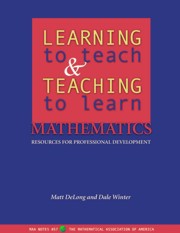Book contents
- Frontmatter
- Preface
- Contents
- 1 The Professional Development Program
- 2 How to Use this Book
- 3 An Orientation Session for the Beginning of the Semester
- 4 Making In-class Groups Work
- 5 Getting Students to Read the Textbook
- 6 Assessing and Evaluating Students' Work
- 7 Managing Homework Teams
- 8 Teaching During Office Hours
- 9 Establishing and Maintaining Control in Your Classroom
- 10 Proctoring Tests and Examinations
- 11 Teaching with Calculators and Computers
- 12 Making Lesson Plans
- 13 Strategies for Motivating Students
- 14 Dealing With Difficult Instructor-Student Situations
- 15 End-of-Semester Administration
- 16 Adapting Materials and Designing Your Own Meetings
- 17 Classroom Visits
- A Tips for Running Meetings
- B The Michigan Introductory Program
- Bibliography
8 - Teaching During Office Hours
- Frontmatter
- Preface
- Contents
- 1 The Professional Development Program
- 2 How to Use this Book
- 3 An Orientation Session for the Beginning of the Semester
- 4 Making In-class Groups Work
- 5 Getting Students to Read the Textbook
- 6 Assessing and Evaluating Students' Work
- 7 Managing Homework Teams
- 8 Teaching During Office Hours
- 9 Establishing and Maintaining Control in Your Classroom
- 10 Proctoring Tests and Examinations
- 11 Teaching with Calculators and Computers
- 12 Making Lesson Plans
- 13 Strategies for Motivating Students
- 14 Dealing With Difficult Instructor-Student Situations
- 15 End-of-Semester Administration
- 16 Adapting Materials and Designing Your Own Meetings
- 17 Classroom Visits
- A Tips for Running Meetings
- B The Michigan Introductory Program
- Bibliography
Summary
As all instructors are aware, teaching opportunities are not confined to the classroom. Office encounters provide one outlet for additional, and in this case more focused and personalized, instruction. Unfortunately, some instructors see office hours as an annoying burden and a waste of time that, in their eyes, could be more fruitfully spent on research or other duties. In addition, many students are reluctant to utilize office hours, because of various beliefs and perceptions that they hold.
Most instructors readily recognize that a primary function of one-on-one teaching in office hours is to provide students with individualized instruction and help. However, few may have reflected upon the other possibilities that such encounters afford—alleviation of mathematics anxiety, motivation, nurturing, retention, feedback (for the instructor as well as the student), etc. For this reason, we begin the meeting with a discussion of the purposes of holding office hours.
Students, on the other hand, often see office hours as a means to get “unstuck,” especially in a mathematics class. Their primary motivation for coming to office hours will then be to enhance their performance on a current homework assignment, or an upcoming quiz or exam. Unfortunately, there are many motivational obstructions that hinder students from coming to office hours for help. Thus, we have included a section of the meeting on ways to encourage students to come to office hours.
Arguably the most important component of one-on-one teaching in a mathematics class is teaching problem solving.
Information
- Type
- Chapter
- Information
- Learning to Teach and Teaching to Learn MathematicsResources for Professional Development, pp. 105 - 114Publisher: Mathematical Association of AmericaPrint publication year: 2002
